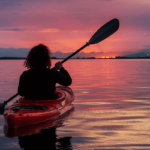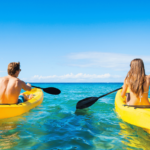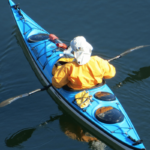Are you tired of your canoe veering off course, turning what should be a serene journey into a frustrating struggle against the water? Mastering the art of canoeing requires skill, patience, and the right techniques to keep your vessel on a straight path. Whether you’re a seasoned paddler or just dipping your oars in the water for the first time, our comprehensive guide on how to stop canoeing in English will equip you with the knowledge to navigate your canoe with ease and confidence. Stay tuned to discover the secrets to a smoother, more enjoyable canoeing experience.
Understanding Canoeing Basics
Before venturing into the waters with your canoe, grasping the fundamentals of canoeing is essential for both your enjoyment and safety. Canoeing, at its core, is about balance, control, and understanding how your movements affect the canoe’s path. The first step is familiarizing yourself with the different parts of the canoe, including the bow (front), stern (back), hull (body), and yoke (crossbar used for carrying the canoe). Knowing these parts will help you communicate more effectively and understand instructions and advice.
Mastering the basic paddling techniques is crucial. A proper paddle grip enhances your control over the canoe and helps prevent fatigue and injuries. The power of your stroke comes from your torso, not just your arms. This means engaging your core, which not only makes your paddling more efficient but also ensures you can paddle longer without tiring. Additionally, understanding how to maneuver your canoe is vital. This includes learning how to execute turns, how to stop, and how to reverse. These maneuvers are not just about changing direction; they’re about doing so efficiently and safely, minimizing the risk of capsizing.
Finally, safety should always be your top priority. This means always wearing a life jacket, regardless of your swimming skills, and being aware of the weather and water conditions before you set out. It’s also important to canoe with a buddy, especially when you’re just starting out. This ensures that help is at hand should you encounter any difficulties.
- Different parts of the canoe: Bow, Stern, Hull, Yoke
- Master basic paddling techniques
- Engage your core for more efficient paddling
- Learn to maneuver: Turning, stopping, reversing
- Prioritize safety: Wear a life jacket, check weather and water conditions, canoe with a buddy
Preventive Measures for Canoeing
Canoeing is an exhilarating outdoor activity that offers both adventure and tranquility in the heart of nature. However, like any water sport, it comes with its inherent risks, especially for beginners. Understanding and implementing preventive measures before and during your canoeing adventure is crucial for ensuring a safe and enjoyable experience on the water. The key to a successful canoeing trip lies not only in the ability to paddle but also in the preparation and knowledge of safety precautions.
First and foremost, always wear a life jacket or personal flotation device (PFD) while canoeing. This is not just a safety recommendation but often a legal requirement in many areas. A properly fitted PFD can be the difference between a minor inconvenience and a life-threatening situation. Additionally, becoming familiar with the waterway you plan to explore is essential. Understand the current, tide, potential obstacles, and know the weather forecast for the day. Sudden weather changes can turn a calm waterway into a challenging environment for canoeists, especially beginners.
Another significant preventive measure is to never canoe alone. Having a buddy means you can look out for each other in case of emergencies. It’s also advisable to inform someone not on the trip about your plans, including your departure and expected return time. In terms of equipment, ensure your canoe is in good condition and you have the necessary gear, such as paddles, a whistle for signaling, a bailing device, and waterproof bags for personal belongings. Lastly, respect the water and wildlife. Maintaining a safe distance from other watercraft and natural inhabitants preserves both your safety and the environment.
Understanding Canoeing Risks and How to Mitigate Them
The excitement of canoeing can sometimes lead individuals to underestimate the potential risks associated with this activity. Fluctuating water levels, hidden underwater obstacles, and the risk of capsizing are genuine concerns that necessitate a respectful and prepared approach to canoeing. By acknowledging these risks and preparing accordingly, canoeists can significantly reduce the likelihood of accidents and injuries on the water.
Enhancing your skills through formal canoeing courses or workshops is a proactive measure that can equip you with the necessary techniques and knowledge to navigate various water conditions safely. Practicing self-rescue techniques and familiarizing yourself with the canoeing equipment will further bolster your confidence and safety on the water.
Key Equipment Checklist for Canoeists
Ensuring you have the right equipment is a fundamental aspect of canoeing safety. The following table outlines essential items every canoeist should consider before embarking on their journey:
| Equipment | Description | Importance |
|---|---|---|
| Life Jacket/PFD | A personal flotation device designed to keep the wearer’s head above water. | Crucial for safety; can be life-saving in case of capsizing. |
| Waterproof Bag | Used to keep personal items dry and secure. | Protects valuables and supplies from water damage. |
| Bailing Device | A tool for removing water from the canoe. | Essential for maintaining buoyancy and balance. |
| Whistle | A signaling device for communication or distress signaling. | Important for attracting attention in emergency situations. |
| Paddles | The primary tool for propelling and steering the canoe. | Must be suitable for the canoeist’s size and strength. |
Canoeing is a rewarding activity that connects individuals with nature and provides a sense of freedom and adventure. By taking the necessary preventive measures, understanding the risks, and preparing accordingly, canoeists can ensure a safe and pleasurable experience on the water. Remember, the best canoeing adventure is a safe one.
Correcting Canoeing Mid-Smoke
Encountering canoeing, where one side of your cigar or joint burns faster than the other, can detract from the enjoyment and overall experience. However, with a bit of knowledge and technique, correcting this issue mid-smoke is entirely possible. The goal is to ensure an even burn, restoring the pleasure and extending the life of your smoke. The process involves understanding the cause of canoeing and applying simple yet effective methods to rectify the issue as soon as it appears.
Firstly, it’s essential to identify the cause of canoeing. Several factors can contribute to this problem, including improper lighting, uneven moisture distribution, and external elements like wind. In most cases, correcting the light can significantly reduce the risk of canoeing. When lighting your cigar or joint, aim to evenly ignite the entire circumference of the end. If canoeing occurs despite a proper light, consider gently rotating your smoke. This method allows the slower-burning side to catch up, aided by the increased air and heat exposure. Additionally, you can try moistening the faster-burning side. A small dab of saliva or water slows down the burn rate, allowing the other side to equalize. However, this technique requires a delicate touch to avoid damaging your smoke or making it too moist.
Another critical aspect is the environment in which you enjoy your smoke. Windy conditions can exacerbate canoeing, directing the burn unevenly. Seeking a more sheltered spot or using your body as a windbreak can help maintain an even burn. Furthermore, regular rotation throughout the smoking process promotes uniform burning, much like turning a rotisserie to ensure even cooking. It’s a simple yet effective strategy that can greatly enhance your smoking experience.
Below is a summary of steps to correct canoeing mid-smoke:
- Identify the cause of canoeing, focusing on the lighting technique and environmental factors.
- Evenly ignite the entire circumference of your cigar or joint at the outset to prevent uneven burning.
- Gently rotate your smoke, allowing the slower-burning side to catch up with the faster-burning side.
- Moisten the faster-burning side slightly if necessary, using a minimal amount of saliva or water.
- Seek shelter from windy conditions or use your body as a windbreak to protect your smoke.
Correcting canoeing mid-smoke is not just about salvaging a single experience but about mastering a skill that enhances every smoke. By paying attention to how you light and maintain your cigar or joint, and by adapting to the environmental conditions, you ensure a smoother, more enjoyable experience. Remember, the key to a great smoke lies in patience, care, and a bit of know-how.
Importance of Even Packing
Even packing is a fundamental aspect of ensuring a safe and enjoyable canoeing experience. Proper distribution of weight within the canoe is crucial to maintain its stability and maneuverability on the water. An unevenly packed canoe can lead to tilting or capsizing, which not only poses a risk to your safety but also makes the journey less enjoyable. By understanding the dynamics of weight distribution, paddlers can significantly enhance their control over the canoe, making it easier to navigate through various water conditions.
When packing a canoe, it is essential to place heavier items in the center of the canoe, close to the bottom. This lowers the center of gravity, which increases stability. Items should be distributed evenly from side to side to prevent the canoe from leaning to one side. It is also important to secure all items firmly in place to prevent them from shifting while on the move. A well-packed canoe responds better to steering and paddling efforts, allowing for smoother and more efficient travel.
Additionally, understanding the principles of even packing goes beyond just arranging gear within the canoe. It encompasses the selection of gear based on its weight and usefulness, ensuring that you are not overburdened with unnecessary items. This strategic approach not only improves the balance and handling of the canoe but also contributes to a safer paddling environment by minimizing the risk of capsizing due to improper weight distribution.
| Item | Weight (Approx.) | Placement Guide |
|---|---|---|
| Waterproof bags | 15 lbs | Center, bottom of the canoe |
| Camping gear | 20 lbs | Center, balanced side to side |
| Food cooler | 25 lbs | Center, close to the bottom |
| Paddles (spare) | 3 lbs each | Along the sides or under seating area |
| Personal items | 5-10 lbs | Distributed evenly, secured in waterproof containers |
Adjusting Humidity and Storage
One of the most critical factors in maintaining the integrity of your canoe and ensuring a safe ending to every journey is understanding the importance of humidity and storage conditions. The material of your canoe, be it wood, fiberglass, or plastic, reacts differently to various humidity levels, which can affect its longevity and performance on the water. Ideally, canoes should be stored in a cool, dry place away from direct sunlight to prevent warping and degradation of materials. By controlling the environment where your canoe is stored, you can significantly extend its life and maintain its structural integrity.
Adjusting the humidity levels in your storage area is crucial, especially for wooden canoes. Wood is particularly susceptible to moisture damage, which can lead to rot or mildew. Using a dehumidifier in your storage space can help maintain an optimal level of humidity that is neither too high nor too low. For those storing canoes outdoors, it’s vital to ensure they are covered and elevated off the ground to avoid direct contact with moisture. Additionally, periodic checks during the off-season can help catch any issues early, preventing long-term damage.
Here are a few practical steps to optimize your canoe storage:
- Regularly inspect the storage area for leaks or dampness and address any issues promptly.
- Use a quality canoe cover that is waterproof yet breathable to protect against the elements.
- Consider the use of a dehumidifier or silica gel packets in enclosed storage spaces to control moisture levels.
- Elevate your canoe off the ground on a rack to ensure air circulation and prevent moisture buildup.
- Avoid storing your canoe near heat sources, as extreme temperature fluctuations can damage the material.
In conclusion, proper storage and humidity control are paramount in preserving your canoe and ensuring it remains safe and reliable for your adventures. By implementing these strategies, you can protect your investment and enjoy many years of paddling. Remember, a well-maintained canoe not only performs better but also ensures that every trip ends as safely as it begins.
I’m Adam Reynolds, a dedicated sports writer with a passion for both competitive gaming and betting. In my mid-thirties, I dive deep into the world of sports, providing insightful analyses and strategies to help readers make informed betting decisions. My experience spans various sporting events, where I blend my love for the game with a keen eye for betting trends. Whether I’m dissecting game tactics or offering betting tips, I aim to deliver content that is both engaging and practical. Join me as we explore the exciting intersection of sports and betting together.





